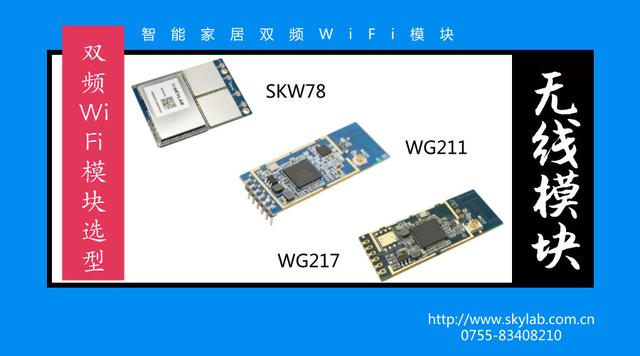Reasons for Optimizing Dual-band WiFi Module for Smart Home Products
With the advent of the intelligent home era, the WiFi module, which is the mainstream wireless communication technology of the Internet of Things, has become almost the best way for the civilian smart home upgrade experience. In such an intelligent terminal product, the data collected by the sensors is processed by the data processing unit and transmitted from the WiFi module to the cloud to realize the connection with the entire network. This SKYLAB Jun talks about why smart home products prefer dual-band WiFi modules.

Smart home
The WiFi module is divided into a single-band WiFi module and a dual-band WiFi module depending on the support of the wireless band signal. The dual-band WiFi module refers to a wireless signal capable of providing two wireless frequency bands simultaneously, namely 2.4 GHz and 5 GHz wireless signals. The single-band WiFi module supports only one wireless band of wireless signals. Compared with the single-band WiFi module, the dual-band WiFi module has a stronger and more stable Wifi wireless signal, a higher speed transmission speed, and can make the wireless device more power-efficient and meet the future HD and big data wireless transmission requirements.
Reasons for the preference of dual-band WiFi module for smart home products
The dual-band WiFi module can work in the 5Ghz band. This band is much cleaner and can easily avoid mutual interference. The advantage of 2.4GHz is that the ability to penetrate the wall is good, the disadvantage is that it is susceptible to interference. The advantages of 5G are its strong anti-interference ability, wide bandwidth, high throughput, and high scalability. The disadvantage is that 5 GHz is only suitable for indoor small-scale coverage and outdoor bridges, and various obstacles have a greater attenuation effect than 2.4 GHz. many.
In the civil sector, various types of devices with WiFi and Bluetooth as the prevailing standards account for a major share of the global market. Among them, the proportion of devices using Bluetooth is even greater; in order to reduce the interference with signals in the 2.4GHz band, smart home terminal products are enhanced. The experience of using dual-band WiFi modules supporting 2.4 GHz and 5 GHz wireless band signals has naturally been favored by engineers.
Dual-band WiFi module:

Dual-band WiFi module
1,802.11 ac AP module: SKW78
The module is compatible with 802.11a/b/g/n/ac, providing customers with high-speed WAN/LAN/WIFI up to 1000Mbps, with high-performance, highly integrated wireless AP solutions. The module is based on the combination of the chips MT7621A, MT7603E, and MT7612E to achieve simultaneous dual-band operation of 2.4G and 5G. In the 2.4G band, the transmission speed can reach 300Mbps; in the 5G band, the transmission speed can reach 867Mbps.
The module supports AP mode, client mode, relay mode, and serial port WiFi.
2, 802.11ac USB WiFi module: WG211
WG211 is compatible with IEEE802.11a/b/g/n/ac1x1 WLANs, and the maximum transmission speed can reach 433Mbps. In 11b mode, the transmission power is 18dBm; in 11n mode, the transmission power is 15~16dBm; in 11ac mode, The transmission power is 9~10dBm and the transmission distance is up to 150m. Can be applied to devices that require high speed WiFi transmission and USB interface.
3, 2.4/5G dual frequency ac USB WiFi module: WG217
The WG217 is compatible with IEEE 802.11ac 1x1 WLANs and has a data transmission rate of 433 Mbps. With a long distance, it also has good wireless connectivity!
The WG217 is designed with security, quality, service, and international regulations as the benchmark. It is designed to provide users with the best performance in any situation and supports the AP/Ad-Hoc/Infrastructure model.
How to choose dual-band WiFi module for smart home solutions:
When the dual-band WiFi module is selected, it is important to pay attention to these parameters of the WiFi module: size, package, frequency range, data rate, transmission rate, transmission distance, communication interface, power supply voltage, and antenna interface.
The above mentioned dual-band WiFi modules can well meet the functional requirements of users and increase the competitiveness of products. At the same time, the WiFi module is easy to use, which can shorten the user's product development cycle and accelerate the time to market! Users can choose according to actual needs!
Suizhou simi intelligent technology development co., LTD , https://www.msmsmart.com
